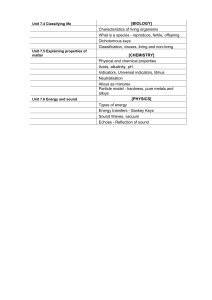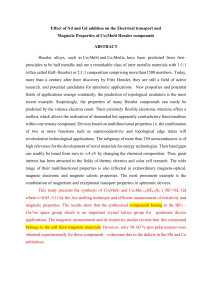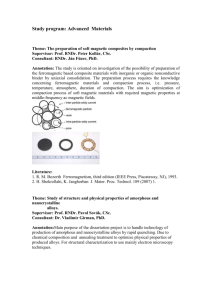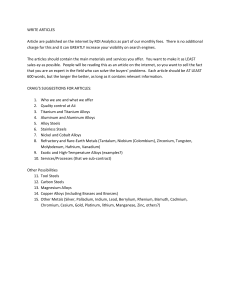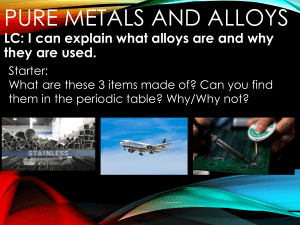Ferromagnetic Alloy Phases: Ni2MnIn, Ni2MnGa, Co2MnGa, Pd2MnSb, PdMnSb
advertisement
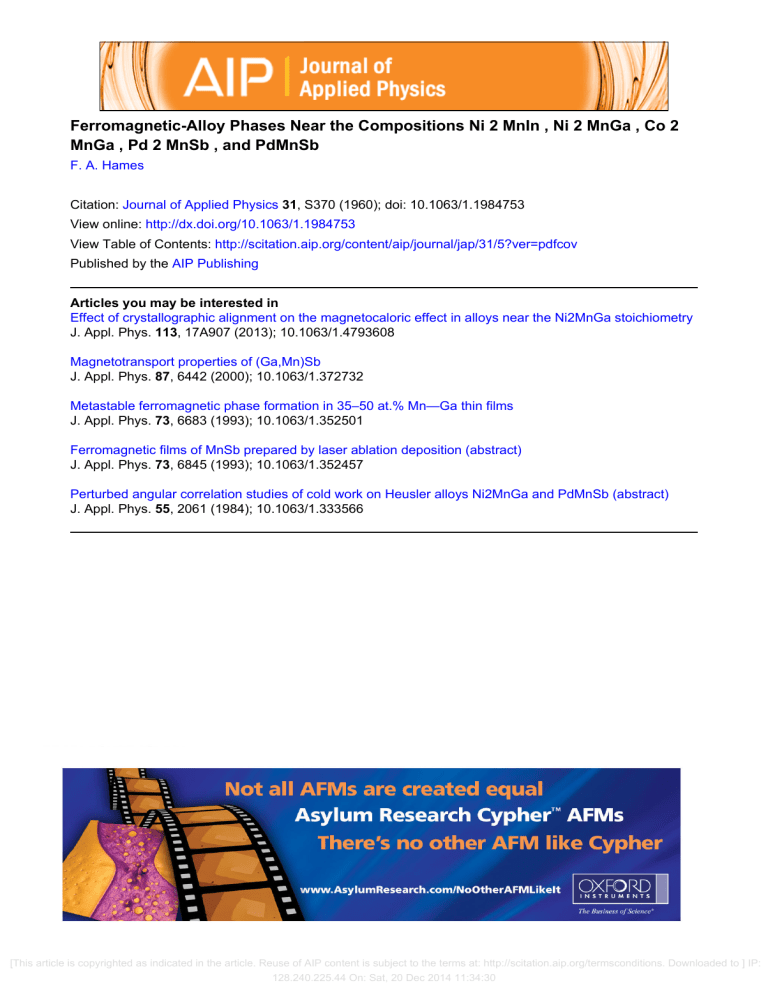
Ferromagnetic-Alloy Phases Near the Compositions Ni 2 MnIn , Ni 2 MnGa , Co 2 MnGa , Pd 2 MnSb , and PdMnSb F. A. Hames Citation: Journal of Applied Physics 31, S370 (1960); doi: 10.1063/1.1984753 View online: http://dx.doi.org/10.1063/1.1984753 View Table of Contents: http://scitation.aip.org/content/aip/journal/jap/31/5?ver=pdfcov Published by the AIP Publishing Articles you may be interested in Effect of crystallographic alignment on the magnetocaloric effect in alloys near the Ni2MnGa stoichiometry J. Appl. Phys. 113, 17A907 (2013); 10.1063/1.4793608 Magnetotransport properties of (Ga,Mn)Sb J. Appl. Phys. 87, 6442 (2000); 10.1063/1.372732 Metastable ferromagnetic phase formation in 35–50 at.% Mn—Ga thin films J. Appl. Phys. 73, 6683 (1993); 10.1063/1.352501 Ferromagnetic films of MnSb prepared by laser ablation deposition (abstract) J. Appl. Phys. 73, 6845 (1993); 10.1063/1.352457 Perturbed angular correlation studies of cold work on Heusler alloys Ni2MnGa and PdMnSb (abstract) J. Appl. Phys. 55, 2061 (1984); 10.1063/1.333566 [This article is copyrighted as indicated in the article. Reuse of AIP content is subject to the terms at: http://scitation.aip.org/termsconditions. Downloaded to ] IP: 128.240.225.44 On: Sat, 20 Dec 2014 11:34:30 JOUR~AL OF APPLIED SUPPLEME:'<T PHYSICS TO VOL. 31, NO.5 MAY, 1960 Ferromagnetic-Alloy Phases Near the Compositions NizMnln Ni 2 MnGa, Co 2 MnGa, Pd 2MnSb, and PdMnSb* ' F. A. HA>!ES Department oj Jletallurgical i,.'ilgineering, Queen's Unic'ersity, Kingston, Ontario . In a .search for .further examples of Heusler-type alloys, ferromagnetic alloys were found near the composition N:,YlnIn, NlzMnGa, Co,MnGa, Pd 2MnSb, and PdYlnSb. The first four alloys are tentatively identified as havmg the L2 1(Heusler)-type structure; PdMnSb, the Cl,-type structure. Previous work has indicated that ferromagnetism in these types of alloys is associated with Mn-Mn distances in the range 4.17-4.37 A. The present work indicates that ferromagnetism persists with Mn-Mn distances as small as 4.08 A (C0 2MnGa) and as large as 4.42 A (PdMnSb); and that ferromagnetism disappears if the Mn-Mn distances become too large. Pd 2MnSb, with Mn-Mn distance 4.55 A, is only feebly magnetic at room temperature. INTRODUCTION T HE Heusler alloys form an interesting group for magnetic study because they offer a possible means of investigating the effects of interatomic distances, atomic arrangement and atomic environment of the magnetic atoms on the occurrence of ferromagnetism on the one hand, and of deducing alloying valences of the metals from measured magnetic moments on the other hand. The classical Heusler alloys are the ferromagnetic copper-manganese-aluminum alloys based on the beta phase (body-centered cubic structure) of the binary copper-aluminum system. They have a rather wide composition range, which includes. the composition CU2MnAl. They have an ordered cubic structure under suitable conditions of heat treatment. Maximum degree of order is obtained at composition CU2MnAI and the atomic arrangement in this alloy is usually assumed to be that proposed by Bradley and Rogers. 1 The structure may be described in terms of the atoms occupying four types of atom sites, herein designated A, B, C, and D, whose coordinates are A 0 0 0 1 1 "2 "2 0 1 1 0 "2 "2 0 t "21 4 3 '4 3 '4 1 4" !3 '4 1 '4 .1. 4 i3 i;! 4" D C B .1. 4 1 "2 1 "2 "2 1 ;! 4 ;! 1 .1. ;! 4 1 i 0 0 "2 0 "21 0 t 0 0 4 '4 3 '4 ;I .1. 4 ;! 4 ;! ;I 1 '4 1- 4' In CU2MnAI, A and C are occupied by eu; B by Mn; and D by Al atoms. This arrangement corresponds with space group Oh"-Fm3m and is the prototype of the "Strukturbericht" L21 structure. Other examples of this structure are found in ferromagnetic manganese alloys having the ideal composition JVhMnX, where M is Cu, Ni, or Co, and X is a B sub-group metal. Pearson2 lists the following examples (lattice constant, a, in parentheses). Cu 2MnAI (5.937); CU2MnGa (?); CU2MnIn (6.1865); * The research for this paper was supported in part by the Defence Research Board of Canada. 1 A. J. Bradley and J. W. Rodgers, Proc. Roy. Soc. (London) A144, 340 (1934). ' 2 W. B. Pearson, A Handbook oj Lattice Spacings and Structures of jilek/is and Alloys (Pergamon Press, New York, 1958). CU2.:\InSn (6.1608); NhMnSb (6.001); Ni 2MnSn (6.036); C02~InSn (5.977). CI I s.t~uctures (space group Ti- F43m) of ideal compOSItIOn :;vIMnX are obtained in some instances by lea:ing half of the M atoms out of the Heusler alloy, ThIS leaves one set of sites (the C sites, for example) unoccupied. Nil'.fnSb (5.903) and ColHnSn (5.956) are in this category. Co::vJ:nSb (5.888) is described as having a Cll-fluorite structure with Co ordered in the A sites, but Mn and Sb occupying the Band D sites randomly. It is not certain that all of the Heusler alloys listed above have an atomic arrangement analogous to that describe.d for CU22'.'lnAI, i.e., M in A -and C; lIn in B; and X III D; space group Oh"-Fm3m. An alternative arrangement is: M in - A and B', Mn in C', and X in D', space group T}- F43m. Determination of the correct arrangement by x-ray diffraction alone is difficult if differences between atomic scattering factors of the atoms are not favorable. Castelliz3 has discussed this problem and has suggested a method of distinguishing between the two arrangements, making use of measured magnetic moments. It is of interest to inquire as to the roles of various atoms in the Heusler alloy as regards contribution to magnetic moment. The B sub-group metal appears to be unimportant, except possibly for its size and valence. These might be important in determining the structure of the alloy and whether or not there is a superiattice, according to the alloying concepts of Hume-Rothery. It is generally assumed that the magnetic moment is due entirely to manganese, although Slater4 has suggested that copper may also be contributing to the magnetization in the copper-manganese-aluminum Heusler alloy. Mn-Mn distances appear to be significant. Coles, Hume-Rothery, and Myers," comparing CU2MnAI with Cu 2MnIn, note a decreasing Curie point with increasing interatomic distance and suggest that in CU2MnIn the critical ratio of interatomic distance to 3d electron shell L. Castelliz, Z. Metallk. 46, 198 (1955). (1930). 5 B. R. Coles, W. Hume-Rothery, and H. P. Myers, Proc. Roy, Soc. (London) A196, 125 (1949). 3 4 J. Slater, Phys. Rev. 36, 57 370S [This article is copyrighted as indicated in the article. Reuse of AIP content is subject to the terms at: http://scitation.aip.org/termsconditions. Downloaded to ] IP: 128.240.225.44 On: Sat, 20 Dec 2014 11:34:30 Ki~Mnln, :\izl\lnGa, Cod,fuGa, PdzlVlnSb, AKD PdMnSb ALLOYS 371S TABLE I. Structure of the alloys (tentative). Q and Fe indicate quenching and cooling in the furnace, respectively, after 24 hrs at the temperature indicated. examples of Heusler alloys has been undertaken. Some preliminary results are summarized in Table 1. -========================== RESULTS AND DISCUSSION Ideal composition a,A :vfn-Mn distance,A L21 (Heusler) Structures 6.07 ~i2~ln][n 6.08 5.86 ~hMnGa 5.83 5.77 C02MnGa 5.78 6.38 PdzMnSb 6.43 4.29 4.30 4.14 4.12 4.08 4.09 4.51 4.55 Ch Structure PdMnSb 4.42 6.25 Treatment Q8WC FC Q 940°C FC Q 940°C FC Q 590°C FC diameter is being approached at which ferromagnetism will disappear. When transition metals such as nickel and cobalt are substituted for copper, the problem of the interpretation of measured magnetic moments is complicated because of the presence of two kinds of potentially magnetic atoms. There is then the question of the relative importance of ~I-J\I, J\1-lIn, and l\fn-i\ln interactions in determining ferromagnetism; and the associated question of the relative importance of M-M, ::V1-Mn, and Mn-Mn distances. The question of the correct atomic arrangement (Oh 5 vs Ti) in the various Heusler alloys is perhaps not significant if it is only the :\In-J\In distances that are important; in both arrangements the shortest IVln-l\In distance is [(2N2]a. On the other hand, if ::\1-::\ln or i\I-M distances are significant, knowledge of the correct arrangement is desirable. In 0,," }1-i\I=a/2; i\I-i\In = [(3)t/4]a, In Ti, :\1-i\1= [(3)t/4]a, i\1-=\In=a/2. This question has been discussed by Castelliz3 in the same reference noted above. As an aid to resolving questions of the relative importance of atomic arrangement, interatomic distances, and the environment of the magnetic atoms on the occurrence of ferromagnetism, a search for further All of the alloys were magnetic in all conditions of heat treatment examined, as indicated by attraction to a magnet; attraction was strong, excepting Pd 2MnSb. The structures indicated are tentative. The X-ray patterns were not inconsistent with the structures indicated, but other structures would give similar patterns, in view of the unfavorable differences in atomic scattering factors. It is noted that the Mn-Mn distances in the strongly magnetic alloys range from 4.08 A (C0 2MnGa) to 4.42 A (Pdl\fnSb), the distances for previously reported alloys of these types range from 4.17 A (NiMnSb) to 4.37 A (Cu2MnIn). In Pd 2MnSb, which is weakly magnetic, the corresponding distance is 4.55 A. CONCLUSIONS 1. Ki 2i\InIn, Ni 2l\InGa, C0 2MnGa, and Pd2l\InSb are tentatively identified as having the L2 1 (Heusler) structure; PdMnSb the Ch structure. 2. Ferromagnetism is strong in the alloys with i\In-Mn distances in the range 4.08 to 4.42 A. 3. Ferromagnetism is weak (at room temperature, at least) in Pd 2MnSb, Mn-Mn 4.55 A. 4. Although it appears that ferromagnetism might be associated with a critical range of Mn-Mn distances, it is not possible at present to separate this effect from the possible ferromagnetism of Ni or Co interactions. ACKNOWLEDGMENTS The writer wishes to acknowledge assistance received from the International Nickel Company. The indium was donated by the Consolidated Mining and Smelting Company of Canada, Limited; and the nickel and cobalt by Sherritt Gordon Mines Limited. Donald Lea and Brian Stevens assisted with the experiments. The permission of the Defence Research Board of Canada to publish this paper is gratefully acknowledged. [This article is copyrighted as indicated in the article. Reuse of AIP content is subject to the terms at: http://scitation.aip.org/termsconditions. Downloaded to ] IP: 128.240.225.44 On: Sat, 20 Dec 2014 11:34:30
